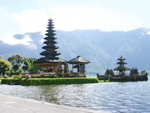Indonesia: Geothermal Development
 Indonesia has the largest geothermal energy potentials in the world; however, the utilization of the resource is still low. The increase in mineral oil prices and the subsequent reduction of the fuel subsidy have considerably improved the feasibility of geothermal in Indonesia. The government plans to launch the second crash program of developing 10,000 MW power plants. Unlike the first crash program, which uses coal as the main resource for power plant, the second program will utilize renewable energy resources such as water, hydro, solar and geothermal. The program will generate power supply of 6,867 megawatt (MW) from geothermal power plants, with total investment of US$ 19.8 billion. This report focuses on recent developments and opportunities for U.S. suppliers of products and services in geothermal.
Indonesia has the largest geothermal energy potentials in the world; however, the utilization of the resource is still low. The increase in mineral oil prices and the subsequent reduction of the fuel subsidy have considerably improved the feasibility of geothermal in Indonesia. The government plans to launch the second crash program of developing 10,000 MW power plants. Unlike the first crash program, which uses coal as the main resource for power plant, the second program will utilize renewable energy resources such as water, hydro, solar and geothermal. The program will generate power supply of 6,867 megawatt (MW) from geothermal power plants, with total investment of US$ 19.8 billion. This report focuses on recent developments and opportunities for U.S. suppliers of products and services in geothermal. Market Data
Indonesia, located in the “ring of fire” volcano belt, is estimated to hold about 40 percent of the world’s geothermal reserves, equivalent to a total of 27,140 megawatts (MW) of power. According to the Ministry of Energy and Mineral Resources (MEMR), there are 253 geothermal locations in Indonesia, of which 2.7% has been utilized as resource for power plant generation. The majority of geothermal locations (63.7%) are in the stage of preliminary survey, 30.5% are in the geology survey and 3.1% in the exploration stage (detail information about the geothermal location can be found at http://www.vsi.esdm.go.id/pbumi/index.html).
The development of the use of geothermal resources is hampered by several factors such as high investment costs, high risk on exploration and exploitation, limited incentives, lack of technology, and lack of implementing rules and regulations. In order to provide a more conducive atmosphere to geothermal development in Indonesia, during the last 2 years, the Government of Indonesia (GOI) has issued several regulations. In addition, the GOI ratified the Kyoto Protocol and participated in the Clean Development Mechanism which provide the opportunities to reduce the investment cost of a geothermal plant by taking the advantage of the global carbon credit program.
Market Demand
The power industry in Indonesia has experienced a high growth in demand, averaging 8% per annum in the last ten years. However, due the lack of infrastructure in the power sector between 2000-2005, Indonesia is still facing a power crisis in various areas. It is predicted, with an average growth rate of 7.2% per year, the electricity demand will increase from 106.456 gigawatt hours (GWh) in 2005 to 149.102 GWh in 2010. At present, renewable energy sources (hydro, solar, wind, biomass, geothermal) contribute only five percent to the total installed generating capacity of 29.5 GW. The Presidential Regulation No. 5/2006 on National Energy Policy stated that by 2025, renewable energy sources will contribute 17% to the total installed generating capacity. Geothermal is expected to contribute about 5% of the total renewable energy sources.
Market Issues & Obstacles
There are no non-tariff barriers inhibiting the importation of geothermal power equipment. Import duties have been progressively reduced over the years in a number of deregulation measures by the government. The Ministry of Finance Decree No. 177/2007 gives an import duty exemption for the companies that have been granted a geothermal working areas/geothermal business license. The Ministry of Finance Decree No. 178/2007 provides fiscal facility for companies in the geothermal business where the GOI will pay the VAT for importation of goods to be used in the exploration activities.
The GOI plans to accelerate the development of geothermal power plants from 2009 to 2018. The program hope is to generate power supply of 6,867 megawatt (MW) from geothermal power plants, with total investment of US$ 19.8 billion. Around $18.7 billion will be needed for the construction of new geothermal power plants, $791 million for operation and maintenance costs of the new plants, and $250 million for maintenance and operation of the existing geothermal power plants.
Upcoming geothermal projects:
- Sarulla, North Sumatra, 330 MW, steam field development, Sarulla Operation Ltd
- Dieng unit 2, Central Java, 60 MW, expansion, PT Geodipa Energi
- Bedugul, 3 x 55 MW and 10 MW, Bali, steam field development, Bali Energy Ltd
- Patuha, 3 x 60 MW, West Java, steam field development, PT Geodipa Energi
- Cibuni, 10 MW, West Java, steam field development, PT Yala Tekno Geothermal
- Salak unit 7&8, West Java, expansion, Chevron Geothermal Indonesia
- Ulumbu , 2 x 3 MW, Nusa Tenggara, steam field development, PT Flores Geothermal Energy
- Gorontalo, 10 MW, Central Sulawesi, steam field development, PT Binatek Reka Energi
Trade Events
Name: Electric Indonesia 2009, Power Indonesia 2009, Renewable Energy Indonesia 2009 Date: 14 - 17 October, 2009 Location: Jakarta International Expo, Kemayoran Website: www.pamerindo.com
Name: Indorenergy 2009 Date: 17 - 19 June 2009 Location: Jakarta Convention Center Website: http://www.napindo.com/
Excerpts from: Indonesia: Geothermal Development, October 2008, US Department of Commerce
You can return to the main Market News page, or press the Back button on your browser.

